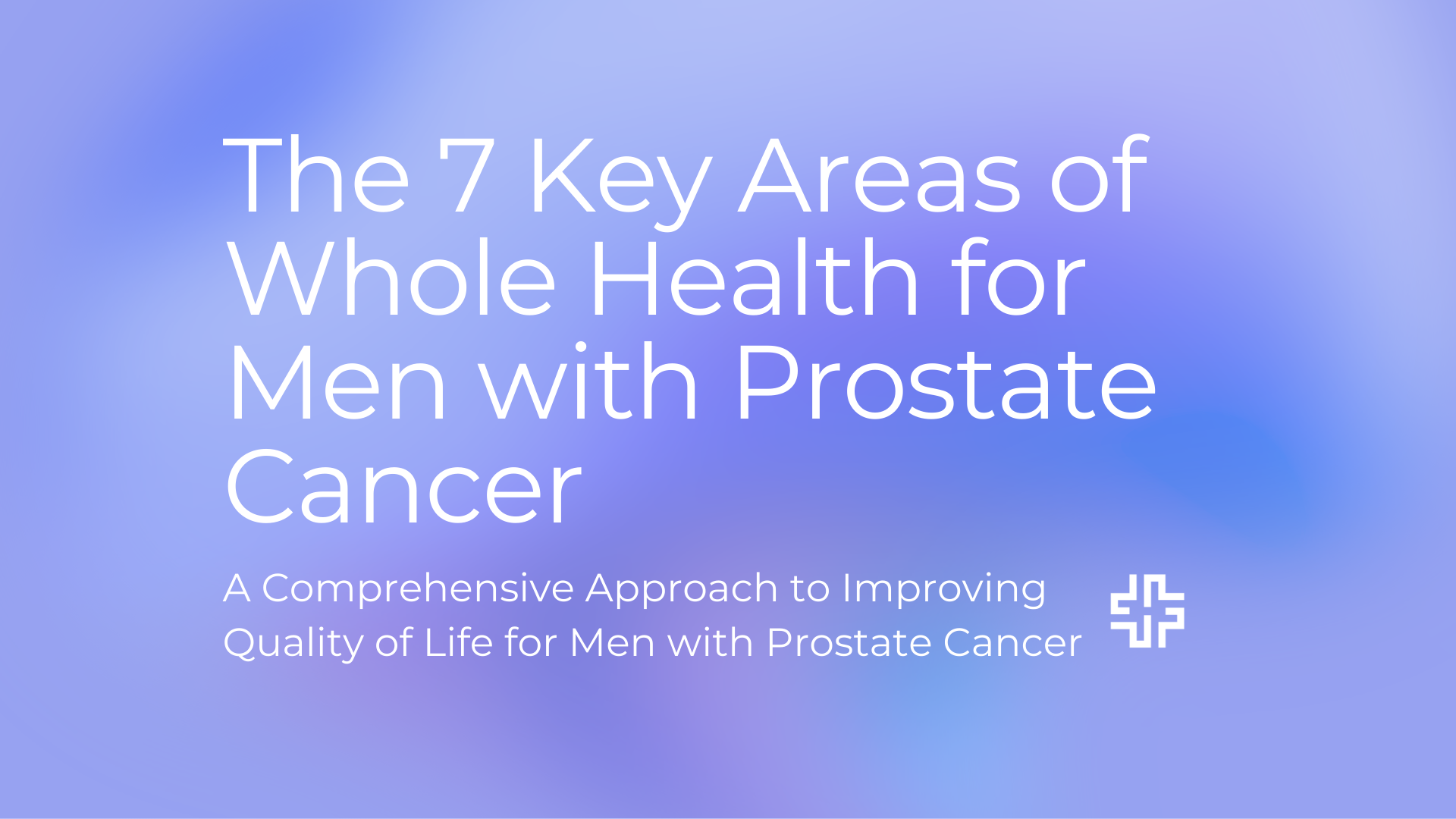
The 7 Key Areas of Whole Health for Men with Prostate Cancer
A Comprehensive Approach to Improving Quality of Life for Men with Prostate Cancer
Introduction
Prostate cancer, one of the most common cancers among men, is a disease marked by the uncontrolled growth of cells in the prostate gland. The impact of prostate cancer varies: while some types grow slowly and may need minimal or no treatment, other forms are aggressive and can spread quickly. This guide is designed for men with prostate cancer and their families. It provides essential tools to understand and fight this disease, enabling them to live life fully. It covers the science of prostate cancer, its treatment, and expert advice on enhancing overall health while eliminating the cancer. This guide explores seven key areas of Prostate Cancer Whole Health, offering a comprehensive understanding of each and how they work together for optimal physical recovery. We begin with mental health, a vital component and the highest priority for prostate cancer patients. It is addressed with expert insights and proven strategies to support mental resilience during cancer treatment. We then discuss a new FDA-approved prostate cancer treatment called Theranostics, explaining how it differs from traditional methods like Chemotherapy and Hormone Therapy. Its minimal side effects allow patients to focus on improving their quality of life through various strategies. The five other key areas we cover in this guide include nutrition and fitness, which are crucial for overall health. We discuss effective exercises for men with prostate cancer and dietary recommendations.
We also explore complementary therapies that combat inflammation and promote healing. The importance of a strong social support system and good sleep habits are emphasized as critical elements of a successful treatment strategy.
The guide aims to empower and inform you about the most innovative and effective options used globally in the fight against prostate cancer.
We now present our report on Prostate Cancer Whole Health, offering clear guidance and groundbreaking and innovative approaches for patients worldwide.



“Creating plans and envisioning the future can serve as a source of preparation and reassurance. Developing these plans may not only provide a sense of readiness for what lies ahead but also offer comfort regarding the future well-being of your family.” – Corissa Brunson M.A., Ed.S – Clinical Professional Counselor
Contemplating the future, especially in the context of advanced prostate cancer, can understandably be challenging and emotionally taxing. Despite receiving treatments that effectively manage the cancer for extended periods, the uncertainty inherent in such situations may evoke feelings of concern.
Individuals diagnosed with prostate cancer may experience periods of emotional distress either prior to or following their treatment. Depression encompasses a spectrum of symptoms, ranging from feelings of melancholy and hopelessness to a diminished interest in previously enjoyed activities and heightened tearfulness.
Moreover, individuals grappling with depression often contend with heightened levels of anxiety and worry. These emotional states can significantly impact one’s daily life, resulting in persistent fatigue, disrupted sleep patterns, and diminished appetite. Furthermore, heightened irritability and anger may manifest.
Should you observe persistent changes in your emotional well-being that endure beyond a few weeks, it is advisable to seek consultation with your general practitioner, hospital physician, or nurse, as there are interventions available to assist.
Engaging in regular physical activity has been shown to significantly reduce symptoms of anxiety and depression.
This finding is supported by a body of research which highlights the mental health benefits of exercise, including improvements in mood and reductions in anxiety levels (Mayo Clinic, 2023).
Additionally, acquiring skills in relaxation techniques, such as yoga or meditation, may prove beneficial.
Each individual navigates their journey with prostate cancer uniquely, and you might discover some of the following recommendations beneficial:
Educate Yourself
Familiarize yourself with your treatment plan to comprehend what to anticipate and understand the available options.
Stay Active
Engage in physical activities to the extent that is comfortable for you. Even gentle activities like walking can contribute to an improved mood.
Open Communication
Share your thoughts with someone trustworthy, be it a close friend, family member, or a professional listener like a counselor or your medical team.
Set Goals
Establish personal goals and things to look forward to, fostering a sense of purpose and optimism.
Community Support
Seek more ideas on self-care from local cancer support centers, as well as organizations like Macmillan Cancer Support, Maggie’s Centers, and Look Good Feel Better. They can offer valuable support and resources tailored to your needs.
Self-Care
Prioritize your well-being by incorporating self-care routines. When ready, explore stress management and relaxation techniques, such as listening to music or practicing breathing exercises.
Explore Resources
There are many resources available through your healthcare provider or online that can assist you and your family on your journey.
Acknowledge Side Effects
Learn about the potential side effects of your treatment to prepare for them and explore strategies to manage them. Our interactive guides offer valuable tips on handling side effects.
Mindful Nutrition
Consider the impact of your diet on your well-being. Many men find that striving for a healthy, balanced diet enhances their ability to cope.
Understanding Psychological Challenges
Prostate cancer, like any serious illness, can bring about a range of psychological challenges. Patients often grapple with intense emotions following their diagnosis, during treatment, and in post-treatment life. Common emotional responses include:
Anxiety and Depression
Research indicates that depression and anxiety are prevalent among cancer patients, affecting up to 20% and 10% respectively, which are rates significantly higher than those seen in the general population (BMJ, 2018).
Emotional Distress Related to Diagnosis and Treatment
The shock of diagnosis and the stress of choosing and undergoing treatment can be overwhelming, impacting the patient's mental well-being.
Effects of Hormonal Therapy
Treatments, especially hormonal therapy, can have side effects that include mood swings and depression. Understanding the mental health implications of these treatments is crucial.

Long-term Mental Health Outcomes
Importance of Ongoing Support
The journey with prostate cancer doesn't end with treatment. Long-term mental health care is essential for addressing any ongoing emotional challenges and promoting a healthy quality of life.
“Being positive is helpful if it’s real. The real issue is about understanding your emotions, tuning in to what they really are, and if you need to, emote. Be sad. Cry. Get it out. This is a trauma. It’s something that causes a lot of emotion. It’s OK to have emotion. I worry more about folks who aren’t quite tapping into that emotion. But it will come out eventually.” – Daniel McFarland, MD
Practical Tips for Mental Well-being
Navigating the mental health landscape while dealing with prostate cancer can be challenging. However, there are several strategies and coping mechanisms that can significantly help in managing emotional and psychological well-being.
Mindfulness and Meditation Practices
Coping Strategies
Mindfulness Techniques: Practices like mindfulness, where the focus is on being intensely aware of what you’re sensing and feeling in the moment, can help in managing stress and anxiety.
Guided Meditation: Regular meditation, especially guided sessions, can offer a peaceful escape from stress and promote a sense of calm and balance.
Healthy Lifestyle Choices
Nutritious Diet: A balanced diet rich in fruits, vegetables, whole grains, and lean proteins can boost overall health and energy levels, positively impacting mental well-being.
Regular Physical Activity: Exercise is not only beneficial for physical health but also for mental health. It releases endorphins, natural mood lifters, and can reduce feelings of anxiety and depression.
Stress Reduction Techniques
Yoga and Deep Breathing: Yoga combines physical postures, deep breathing, and meditation or relaxation. It can help in reducing stress and improving mental clarity and focus.
Routine and Structure: Establishing a routine that includes dedicated time for relaxation and stress reduction activities can be beneficial.
Counseling
Professional Support: Seeking professional counseling or therapy can provide a safe space to discuss fears, anxieties, and challenges. Therapists specializing in cancer care can offer tailored advice and coping strategies.
Cognitive Behavioral Therapy (CBT): This type of therapy can be particularly effective in changing negative thought patterns and developing healthier coping mechanisms.
For instance, research has shown that CBT can significantly reduce symptoms of depression and anxiety and is considered at least as effective as other forms of psychotherapy. It’s also been highlighted for its adaptability, being effective in individual, group, and even internet-based formats, which broadens its accessibility and applicability in different clinical settings (JAMA Network; BMC Psychiatry).
In conclusion, managing mental health during prostate cancer involves a combination of acknowledging and expressing fears, seeking support, engaging in mindfulness and stress reduction practices, maintaining a healthy lifestyle, and, if necessary, seeking professional counseling.
These strategies collectively contribute to a more balanced and positive mental state, which is crucial in the journey of prostate cancer treatment and recovery.

Introduction to Theranostics
What is Theranostics?
Theranostics is a groundbreaking medical approach that combines diagnostics and therapy into a single, integrated process. The term “Theranostics” itself is a fusion of two essential components: “Therapy” and “Diagnostics.” This innovative approach allows doctors to tailor treatment to an individual’s unique genetic makeup and disease characteristics, thereby improving the effectiveness of treatment while minimizing side effects.
In the realm of prostate cancer treatment, Theranostics has emerged as a game-changer. Researchers have developed Prostate-Specific Membrane Antigen (PSMA) PET scans, which specifically target prostate cancer cells. These scans can help doctors detect and locate prostate cancer cells with unparalleled accuracy.
Theranostics has progressed to include targeted therapies that deliver precise doses of radiation to cancer cells while sparing healthy tissues.
One notable example is Lutetium-177 PSMA therapy, which uses a radioactive isotope to specifically target and destroy prostate cancer cells. This personalized approach minimizes collateral damage to surrounding tissues, reducing side effects and improving the patient’s quality of life.
How Does Theranostics Differ from Other Treatments?
Personalized Precision Medicine: Theranostics is all about personalized care. Unlike one-size-fits-all treatments, Theranostics can help your oncologist tailor this therapy to the unique genetic and molecular characteristics of your prostate cancer.
Simultaneous Diagnosis and Treatment: The name “Theranostics” itself is a fusion of “therapy” and “diagnostics,” highlighting its dual role. Traditional treatments often involve a series of tests and evaluations to monitor progress. In contrast, Theranostics allows for real-time monitoring and adjustment, seamlessly integrating diagnostics and treatment into a single, continuous process.
Reduced Side Effects: One of the major advantages of Theranostics is its potential to minimize collateral damage to healthy tissues. By specifically targeting cancer cells, Theranostics aims to minimize side effects typically associated with traditional treatments like surgery, radiation, or chemotherapy. This approach can lead to a higher quality of life during and after treatment.
Enhanced Efficacy: Traditional treatments may become less effective as cancer evolves or develops resistance. Theranostics has the flexibility to adapt to these changes. By continuously monitoring your cancer’s response, doctors can adjust the therapy to maximize its effectiveness, potentially extending the treatment’s benefits.
Improved Quality of Life: The goal of Theranostics is not just to treat cancer but to help you maintain your quality of life. By minimizing side effects and tailoring treatment to your specific cancer type, it aims to provide a more comfortable and sustainable approach to managing advanced prostate cancer.


Treating Prostate Cancer with Theranostics
How It Works – 5 Steps for Success
Identifying the Culprit Cells
At the core of Theranostics is the ability to pinpoint the exact prostate cancer cells responsible for your condition. This precision starts with advanced imaging techniques such as PSMA (Prostate Specific Membrane Antigen) PET scans. These scans utilize radiolabeled (Radioligand) molecules that specifically bind to prostate cancer cells.
Locating the Targets
Once these radiolabeled molecules attach to the cancer cells, the tiny amount of radiation they emit is detectable through PET or SPECT scans. This allows your medical team to precisely locate the cancer cells, determining their size, spread, and activity.
Customized Treatment
Armed with this information, your oncologist can tailor a targeted treatment plan. Theranostics goes beyond a one-size-fits-all approach. It is designed to seek out, attach to, and destroy cancer cells and lesions while sparing healthy tissue.
Delivering the Therapeutic Punch
The radiolabeled compounds not only locate the cancer cells but also deliver therapeutic doses of radiation to them. This radiation destroys the cancer cells at the cellular level, disrupting their ability to multiply and grow.
Monitoring Progress
Theranostics doesn’t stop at treatment; it also allows for continuous monitoring of your progress. Follow-up imaging can assess the treatment’s effectiveness, in real-time, helping your medical team make any necessary adjustments to your personalized therapy plan.

Beneficial Foods and Nutrients for Prostate Health
The diagnosis of prostate cancer presents a myriad of challenges, particularly in understanding how lifestyle and dietary choices can influence the progression and management of the disease. While the primary approach involves medical treatments, the role of nutrition in supporting overall health and well-being is pivotal. This section explores the crucial role of nutrition in reducing prostate cancer risk and aiding in its treatment.
Several studies have established a link between high caloric intake and an increased risk of various cancers, including prostate cancer. For instance, a case-control study reported in the Journal of the National Cancer Institute found a significant association between high calorie consumption and the risk of prostate cancer.
Specifically, the study observed a 115% increase in the risk of local prostate cancer and a 96% increase in the risk of regional or distant prostate cancer among individuals who consumed over 2,439 calories per day, compared to those whose caloric intake was less than 1,322 calories per day (Kenfield et al., 2008).
In a similar vein, research published in Cancer Prevention Research indicated a nearly fourfold increase in prostate cancer risk among men whose daily caloric intake exceeded 2,624 calories, in contrast to those who consumed the least, at approximately 1,064 calories daily (Wright et al., 2010). These studies highlight the potential impact of dietary habits, particularly caloric consumption, on the risk of developing prostate cancer.


Vitamin E
This fat-soluble antioxidant plays a critical role in cellular health, particularly in the prostate. It helps protect cells from damage caused by free radicals, molecules that can contribute to the development of cancer. There’s evidence suggesting that vitamin E may specifically benefit prostate cell health, although its effects on cancer prevention are still under investigation.
Selenium
An essential mineral, selenium contributes to the protection of cells from oxidative stress. It’s been studied for its potential role in reducing the risk of prostate cancer, although findings are mixed. Selenium is believed to support the immune system and may help in preventing cell damage.
Omega-3 Fatty Acids
These polyunsaturated fats, found abundantly in fish oils, are known for their anti-inflammatory properties. Chronic inflammation is a risk factor for many types of cancer, including prostate cancer. Omega-3 fatty acids may help manage inflammation, potentially reducing the risk or progression of prostate cancer.
Recommended Foods
Phytochemicals (Lycopene)
Lycopene: A powerful antioxidant found in tomatoes, watermelon, and other red fruits and vegetables. Lycopene is particularly noted for its potential benefits in prostate health. Research suggests it may help lower the risk of developing prostate cancer and may also slow the growth of cancer cells in the prostate.
Fruits and Vegetables
These are rich sources of antioxidants, vitamins, and fibers. They not only contribute to overall health but are particularly beneficial for the prostate. The variety of antioxidants found in fruits and vegetables, like vitamins C and E, can help protect prostate cells from damage.
Whole Grains
Whole grains, such as brown rice, quinoa, and whole wheat, are an important part of a balanced diet. They provide essential nutrients, including fiber, vitamins, and minerals. Dietary fiber from whole grains is linked to a lower risk of prostate cancer and can aid in maintaining a healthy weight.
Lean Proteins
Lean protein sources, including fish, poultry, and plant-based proteins like beans and lentils, provide essential nutrients without the high levels of saturated fats found in red meats. These proteins are vital for muscle health and overall bodily function.
Foods to Limit
Red and Processed Meats
Consumption of these meats has been linked to an increased risk of prostate cancer. They often contain high levels of saturated fats and chemicals used in processing, which can contribute to cancer risk.
High-Fat Dairy Products
High-fat dairy products can be rich in saturated fats. Some studies suggest that high consumption of these products may be linked to an increased risk of prostate cancer, although the evidence is not conclusive.
Sugary Foods and Drinks
Excessive intake of sugar can contribute to obesity, diabetes, and heart disease, all of which can impact overall health, including prostate health. Moderation is key to maintaining a balanced diet and reducing the risk of these health issues.

In summary, focusing on a diet rich in antioxidants, omega-3 fatty acids, and phytochemicals, while limiting the intake of red and processed meats, high-fat dairy, and sugary foods, can contribute significantly to maintaining prostate health and potentially reducing the risk of prostate cancer.
As mentioned above, there is not a silver bullet of specific foods that are 100% linked to prostate cancer. It’s more around eating healthier and giving your body every advantage when fighting prostate cancer.
Body Mass Index
Guidance on determining and maintaining a healthy Body Mass Index (BMI) is of paramount importance for men fighting prostate cancer, as it plays a critical role in their overall health and well-being. BMI is a numerical measure that takes into account a person’s height and weight and is widely used to assess whether an individual falls within a healthy weight range.
Here’s a more detailed breakdown of this crucial aspect of prostate health:
Assessing BMI
To begin, men should calculate their BMI, which can be done using readily available online calculators or with the guidance of a healthcare provider. BMI values fall into different categories, such as underweight, normal weight, overweight, and obesity. For prostate health, achieving and maintaining a BMI within the normal weight range (typically 18.5 to 24.9) is recommended.
The Importance of Healthy Weight
Maintaining a healthy BMI is crucial because excessive body weight, particularly obesity, has been linked to an increased risk of prostate cancer progression and recurrence. Elevated BMI is associated with inflammation and hormonal changes that may adversely affect prostate health.
Weight Management Strategies
For men with prostate cancer, achieving a healthy BMI involves adopting a multifaceted approach. This includes a combination of balanced nutrition and regular physical activity. Consulting with a registered dietitian or healthcare provider can help develop personalized dietary and exercise plans tailored to individual needs and treatment goals.
Nutrition and BMI
A balanced diet that focuses on whole, nutrient-dense foods is essential. This means emphasizing fruits, vegetables, lean proteins, whole grains, and healthy fats while limiting the consumption of sugary, high-calorie, and processed foods. Achieving and maintaining a healthy BMI often involves calorie control and portion management.
Physical Activity
Regular physical activity is a key component of maintaining a healthy weight and BMI. Exercise helps burn calories, build muscle, and improve overall metabolic health. Depending on the individual’s fitness level and treatment status, exercise programs should be adapted to ensure safety and effectiveness.
Monitoring Progress
It’s important for men with prostate cancer to regularly monitor their BMI and assess their progress toward achieving a healthy weight. Periodic consultations with healthcare professionals can help track changes and make necessary adjustments to their dietary and physical activity plans.

“Most likely, it’s not just the exercise that counts — it’s the subsequent weight loss that also makes a difference. Studies have linked obesity with particularly aggressive forms of prostate cancer, and separate research has also connected weight gain with an increased risk of recurrence in men who have already been treated.” – Dr. Michael Hiroshi Johnsonz
The Integral Role of Exercise in Prostate Cancer Prevention and Management
This section will delve into the pivotal role of regular physical activity in both preventing and managing prostate cancer. It will explore how exercise not only enhances overall health but also specifically targets and mitigates factors contributing to cancer risk and progression, offering a holistic approach to prostate cancer care.
Regular physical activity plays a crucial role in both the prevention and management of prostate cancer. Its benefits are extensive, influencing not just overall health but also specifically targeting factors that contribute to cancer risk and progression.
Direct Impact on Prostate Cancer
Reduction in Mortality
Studies have shown remarkable outcomes, with one study indicating that vigorous exercise for three or more hours per week can lower the risk of death from prostate cancer by 61%. This significant reduction highlights the powerful impact of regular, intense physical activity on prostate cancer outcomes.
Mechanisms Behind the Benefits
Exercise can lower levels of certain hormones, like insulin and insulin-like growth factors, which are linked to cancer growth.
Weight Management
As obesity is a risk factor for prostate cancer, regular exercise plays a vital role in maintaining a healthy weight.
Psychological Well-being
Regular exercise also offers significant psychological benefits, reducing stress, anxiety, and depression, crucial for those diagnosed with or being treated for prostate cancer.
Immune System Enhancement
Physical activity strengthens the immune system, aiding in the detection and combat of cancer cells.
Inflammation Reduction: Chronic inflammation is a risk factor for various cancers. Exercise helps reduce these inflammatory markers.
Recommendations for Physical Activity
Type of Exercise
A mix of aerobic and strength training exercises is generally recommended. Running, cycling, swimming, and high-intensity interval training are particularly effective.
Frequency and Duration
Consistency is key. The American Cancer Society advises at least 150 minutes of moderate-intensity or 75 minutes of vigorous-intensity exercise weekly.


How Exercise Reduces Cancer Risk
Weight Management
Maintaining a healthy weight through regular exercise reduces the risk of prostate cancer.
Inflammation Reduction
Exercise’s anti-inflammatory effects can lower the risk of several cancers, including prostate cancer.
Hormone Regulation
Exercise impacts hormone levels, including testosterone, which is associated with prostate cancer risk.
Prostate Cancer and Physical Activity Research
Disease Development and Mortality
Regular physical activity is linked to a lower likelihood of developing prostate cancer and a reduced risk of dying from the disease.
Weight Loss and Screening Effectiveness
Exercise-induced weight loss is significant, as obesity is related to more aggressive prostate cancer forms. Exercise can also improve the effectiveness of prostate cancer screenings by reducing obesity-related interferences.
Prostate Cancer Foundation Recommendations
Staying Active
The Prostate Cancer Foundation emphasizes the importance of physical activity for prostate cancer survivors, tailored to individual fitness levels.
Mental Health Benefits of Exercise
Enhanced Mental Health
Beyond physical health, exercise significantly benefits mental health, reducing stress, anxiety, and depression in men with prostate cancer.
In conclusion, incorporating regular physical activity into a prostate cancer prevention and management strategy is crucial. Its wide-ranging benefits, from reducing mortality risk to improving mental health, make it an essential component of comprehensive cancer care.
“We found in this study that the exercise group had lower prostate cancer-specific anxiety compared to the group that didn’t exercise,” – Kerry Courneya, PhD
For more info about exercise and prostate cancer, check out our comprehensive guide here >>>
Here are some example exercise routines that have been proven to be helpful for men with prostate cancer:
Aerobic Exercise for Cardiovascular Health
Brisk Walking
Engaging in brisk walking can improve cardiovascular health and overall well-being in prostate cancer patients (Galvão et al., 2018). It helps maintain healthy blood flow and reduce the risk of cardiovascular complications often associated with cancer treatments (Harrington et al., 2010).
Strength Training to Combat Muscle Loss
Bodyweight Exercises
Bodyweight exercises such as squats and push-ups are essential for preventing muscle loss, a common concern during prostate cancer treatment (Galvão et al., 2015). They help maintain muscle strength and functional capacity (Cormie et al., 2017).
Resistance Bands
Resistance band exercises are effective in preserving muscle mass and strength, which can be especially important for prostate cancer patients undergoing treatment (Cormie et al., 2017).
Flexibility and Stress Reduction
Yoga
Yoga has been shown to improve flexibility and reduce stress in cancer patients, including those with prostate cancer (Campo et al., 2018). It can enhance relaxation and overall quality of life during treatment (Cramer et al., 2013).
Tai Chi
Tai Chi can improve balance and flexibility, reducing the risk of falls in prostate cancer patients (Campo et al., 2018). It offers benefits for physical and psychological well-being (Tao et al., 2017).
Pelvic Floor Exercises (Kegels) for Urinary Health
Kegel exercises are crucial for maintaining and improving urinary continence in prostate cancer survivors (Filocamo et al., 2018). They strengthen the pelvic floor muscles and aid in managing urinary incontinence, a common side effect of treatment (Tienforti et al., 2012).

Balance and Coordination for Fall Prevention
Balance Exercises
Prostate cancer patients can benefit from balance exercises to prevent falls and improve overall stability, particularly if they experience muscle weakness due to treatment (Campo et al., 2018). These exercises help reduce the risk of injuries (Galvão et al., 2017).
Breathing and Relaxation Techniques for Stress Management
Incorporating deep breathing exercises and relaxation techniques is essential for managing stress and anxiety in prostate cancer patients (Zainal et al., 2019). These practices contribute to enhanced mental well-being during cancer treatment (Bower et al., 2015).

Understanding Complementary Therapies
Complementary therapies encompass a diverse range of practices that can support conventional medical treatments for prostate cancer.
These therapies, which include dietary modifications, massage, hypnotherapy, yoga, and more, are designed to work alongside standard medical treatments rather than replace them. They can offer benefits in managing symptoms, improving emotional wellbeing, and enhancing overall health.
Potential Side Effects and Interactions
Some complementary therapies might have side effects or interact with standard prostate cancer treatments. It’s crucial to be aware of these possibilities.
Variability in Research and Regulation
The level of scientific research and regulation varies significantly among different complementary therapies. Therefore, a well-informed, cautious approach is advisable.
Consultation with Healthcare Providers
Before embarking on any complementary therapy, it’s essential to discuss it with your healthcare team to ensure it’s safe and appropriate for your specific condition.
“The major role of a physician is to provide advice about two areas, efficacy and safety. I tend to divide these therapies into three categories based on safety and efficacy: the first category consists of those that are both safe and have evidence of effectiveness; the second includes those that are safe but lack evidence of efficacy; and the third consists of those that are unsafe and have been proven ineffective.
The middle category is by far the largest. It includes herbs such as saw palmetto, which some men take for BPH. These herbs and botanicals are probably safe when used alone. But in many cases there is no evidence that they actually have any effect, or the only evidence has come from small pilot studies rather than from randomized clinical trials. So the evidence is suggestive, not conclusive.”
– Dr. David S. Rosenthal
Therapist Interviews: Practitioner Insights
Choosing the Right Therapist
Look for practitioners who have experience working with cancer patients and who are willing to collaborate with your medical team.
Personalized Approach
Every patient’s experience with prostate cancer is unique, and so should be their complementary therapy approach.
Evidence-Based Practices
Focus on therapies that have been backed by scientific research. For example, mindfulness meditation for stress reduction or acupuncture for pain management
Understanding Risks
Be aware of any potential risks associated with a therapy, and how it might affect your prostate cancer treatment.
Cost and Accessibility: Guidance on Accessing Therapies
Insurance Coverage
Some therapies might be covered by insurance. It’s important to check with your provider.
Community Resources
Explore local community centers or cancer support groups that may offer complementary therapies at reduced costs or for free.
Online Platforms
For therapies like yoga or meditation, online resources can be both cost-effective and accessible.
In summary, while complementary therapies can offer significant benefits for prostate cancer patients, it’s crucial to approach them with a well-informed and cautious perspective. Collaboration with healthcare providers, a focus on safety and efficacy, and considerations around cost and accessibility are key factors in successfully integrating these therapies into your prostate cancer care plan..

Connecting with Others Facing Prostate Cancer
When dealing with prostate cancer, the journey extends beyond the physical aspects of the disease. It encompasses a range of emotional and mental challenges that can often feel overwhelming. In such times, the support and understanding derived from connecting with others facing similar battles can be a lifeline.
This section delves into the multifaceted benefits of building connections with fellow prostate cancer patients and survivors, highlighting how shared experiences can foster a sense of community, provide emotional support, and offer practical advice and insights into dealing with the disease.
Facing prostate cancer can be a challenging journey, not just physically but emotionally and mentally as well. Connecting with others who are going through similar experiences can provide invaluable support and understanding.
One-to-One Support Services
Personalized Interaction
Engage in conversations with individuals who have firsthand experience with prostate cancer. This one-on-one interaction can offer a unique perspective and understanding that only someone who has walked a similar path can provide..
Sharing Experiences
This type of support allows for an intimate exchange of personal experiences, coping strategies, and practical advice, tailored to your specific situation.
Joining an Online Community
Virtual Support
Online communities offer a platform to connect with others from the comfort of your home. These forums are ideal for those who prefer digital communication or may have mobility or travel limitations.
Diverse Discussions
Here, you can openly discuss a wide range of topics – from medical queries and treatment experiences to emotional support and personal stories. These platforms often facilitate anonymity and a judgment-free environment.

Support Groups (see appendix)
Group Settings for Shared Experiences
Participate in support groups where discussions about prostate cancer journeys are encouraged. These groups provide a sense of community and collective wisdom.
Variety of Groups
Some groups are led by healthcare professionals offering expert guidance, while others are peer-led, offering more personal experience-based advice.
Inclusive Environment
Many groups also welcome the participation of family members, friends, and caregivers, recognizing the importance of a support system.
Supporting Family Members and Caregivers
Guidance for Families
For family members and caregivers of those with prostate cancer, understanding how to provide support is crucial. Resources and guides are available to navigate this role effectively.
Community Resources: Support Groups and Communities
Accessibility
Look for local support groups, hospital-based groups, or online communities. Accessibility is key, so choose the option that best fits your lifestyle and preferences.
Diverse Offerings
Different groups offer different benefits – some focus on emotional support, others on practical advice or medical information.
Family and Caregiver Advice
Understanding and Empathy
Learn about the emotional and physical challenges of prostate cancer to provide empathetic and informed support.
Communication is Key
Open lines of communication are vital. Encourage your loved one to express their feelings and needs.
Patient Advocacy Information
Rights and Advocacy
Patients have rights to quality care, privacy, and informed decision-making. Being aware of these rights is crucial.
Seeking Advocacy Services
Utilize patient advocacy services for assistance with healthcare navigation, treatment decisions, and insurance issues.
The journey through prostate cancer is not one that should be walked alone. Connecting with others who understand, whether through one-on-one conversations, online communities, or support groups, can make a significant difference in coping with the disease. For families and caregivers, gaining knowledge and understanding of how best to support their loved one is equally important. Remember, the power of connection can be a beacon of hope and strength in the prostate cancer journey.
If you’re a family member of someone with prostate cancer and you’re looking for more specific advice on supporting your loved one, check out our guide on Supporting Loved Ones with Prostate Cancer: A Guide for Family and Friends >>>

Scientific Background
Sleep disturbances are common in individuals with prostate cancer, often as a result of the physical and emotional stress of the disease and its treatments. Disrupted sleep patterns can exacerbate fatigue, affect mood, and impair overall quality of life. Understanding the connection between prostate cancer and sleep is crucial for effective management.
Key Aspects of Sleep Disturbances in Prostate Cancer
Impact of Treatments
Treatments such as hormone therapy can disrupt normal sleep patterns, leading to insomnia or sleep apnea.
Anxiety and Stress
Worry about the illness and its future can lead to difficulties in falling or staying asleep.
Physical Discomfort
Pain or urinary symptoms associated with prostate cancer can interrupt sleep.
Prostate cancer patients often face a multitude of challenges, including various sleep disturbances. These disturbances can be due to physical pain from the cancer itself or its treatments, emotional stress and anxiety related to the diagnosis and future concerns, or even the side effects of medications and therapies used in treatment. Such sleep problems are not just a matter of discomfort; they significantly affect a patient’s ability to cope with cancer by weakening physical health and mental resilience, and potentially exacerbating other existing health conditions.
The importance of sleep cannot be overstated, particularly for individuals battling prostate cancer. Adequate rest is crucial as it plays a vital role in immune system function, helping the body to repair and fight off cancer cells more effectively. Additionally, sleep is instrumental in emotional regulation and mood improvement. A good night’s rest can significantly reduce anxiety and depression levels, making the day-to-day challenges of cancer treatment more manageable and improving overall quality of life.
However, achieving restorative sleep is often easier said than done for many prostate cancer patients. Disruptions such as frequent wakefulness or difficulty falling asleep can severely impact sleep quality and duration. This not only leaves patients feeling fatigued and less able to cope with physical aspects of their disease but also wears down their mental fortitude, making them more susceptible to stress and negative emotions.
A revealing study from Oxford has underscored the serious implications of sleep disturbances in prostate cancer patients. The research found that increased periods of wakefulness after initially falling asleep, a common indicator of poor sleep quality, were associated with a higher risk of developing prostate cancer. This association highlights the critical need for addressing sleep issues as part of comprehensive cancer care, emphasizing the importance of sleep quality on overall health outcomes.
Addressing these sleep challenges not only helps in mitigating the immediate discomfort but also contributes to a better prognosis and quality of life by bolstering the patient’s immune response and emotional well-being.
If you are a prostate cancer patient having trouble sleeping, there are a number of things you can do to improve your sleep hygiene.
Practical Tips for Better Sleep
Create a Restful Environment
Optimize Bedroom Conditions
The sleep environment plays a crucial role in the quality of rest. This means ensuring the bedroom is dark, quiet, and cool. Utilize blackout curtains to block out light and consider using a white noise machine to mask disruptive sounds.
Comfortable Bedding
Invest in comfortable, high-quality bedding. The right mattress and pillows can make a significant difference in sleep quality.
Electronics-Free Zone
Minimize the use of electronic devices in the bedroom. The blue light emitted by screens can interfere with the production of melatonin, a hormone that regulates sleep.
Establish a Sleep Routine
Consistent Sleep Schedule
Go to bed and wake up at the same time daily, including weekends. This consistency helps regulate your body’s internal clock, making it easier to fall asleep and wake up naturally.
Pre-Bedtime Rituals
Develop calming pre-sleep rituals like reading, listening to soft music, or taking a warm bath.
Limit Stimulants
Avoid Caffeine and Alcohol
Reduce intake of caffeine and alcohol, particularly in the evening. Both substances can disrupt sleep patterns and affect sleep quality.
Watch Your Diet
Avoid heavy meals close to bedtime. Opt for a light snack if you’re slightly hungry.
Exercise Regularly
Physical Activity
Regular exercise, particularly aerobic activities like walking or swimming, can significantly improve sleep quality. However, avoid vigorous workouts close to bedtime as they may increase alertness.
Timing of Exercise
Try to exercise earlier in the day, as evening workouts can stimulate the body and make it harder to wind down.
Mindfulness and Relaxation Techniques
Mindfulness Meditation
Practices like mindfulness meditation can reduce stress and promote relaxation, making it easier to fall asleep.
Deep Breathing and Gentle Yoga
Engage in deep breathing exercises or gentle yoga stretches in the evening to relax your body and mind.
Community Resources: Support Groups and Communities
Seeking Sleep-Focused Groups
Explore support groups specifically addressing sleep issues in prostate cancer patients. These groups provide a platform to share experiences and tips for better sleep.
Inclusion in Prostate Cancer Discussions
Even general prostate cancer support groups can offer insights into managing sleep disturbances as a part of overall care.
Family and Caregiver Advice
Educate on Sleep’s Role
Family members should be informed about the importance of sleep in health and recovery. They can play a crucial role in creating a conducive sleep environment.
Assistance with Sleep Routines
Help the patient adhere to a consistent sleep schedule and engage in relaxing activities before bed.
Patient Advocacy Information
Advocating for Quality Sleep
Patients should feel empowered to discuss any sleep-related issues with their healthcare providers and seek solutions or referrals to sleep specialists if necessary.
Access to Sleep Specialists
If sleep disturbances persist, consider consulting a sleep specialist for a comprehensive assessment and tailored interventions.
Good sleep hygiene is essential for prostate cancer patients, not only to improve sleep quality but also to enhance overall health and well-being. By integrating these practical tips, seeking support from the community, and utilizing available resources, patients can significantly improve their sleep experience.
View Our Guide for Managing Sleep Disturbances During Prostate Cancer Treatment >>>
Additional Tips

Engaging in regular mindfulness or meditation practices to reduce stress and promote mental calmness.
Seeking support from counseling or therapy to navigate the emotional challenges of prostate cancer.
Making sure your bedroom is dark, quiet, and cool.
Getting regular exercise, but avoiding strenuous activity too close to bedtime.

Establishing a regular sleep schedule and sticking to it as much as possible, even on weekends.
Creating a relaxing bedtime routine that includes activities such as taking a warm bath, reading a book, or listening to calming music.
Avoiding caffeine and alcohol before bed.
Seeing a doctor if you have trouble sleeping despite making lifestyle changes.
